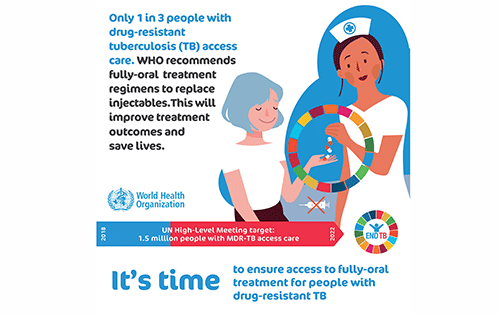The health ministry announced that the country is still dealing with the challenge of missing tuberculosis cases, which are usually undiagnosed, untreated and primarily the source of transmission.
Every year, World TB Day is commemorated on 24 March to raise public awareness about the devastating health, social and economic consequences of TB, and to step up efforts to end the global TB epidemic. The date marks the day in 1882 when Dr Robert Koch announced that he had discovered the bacterium that causes TB, which opened the way towards diagnosing and curing this disease.
TB remains one of the world’s deadliest infectious killers.
In 2021, the World Health Organisation (WHO) estimated this to be 44% of cases. The Centres for Disease Prevention and Control (CDC) stated that each year, 10 million people develop active TB, but 3.6 million of these individuals are ‘missed’ each year by health systems, and do not get the TB care they need and deserve. More than 75% of missed cases are concentrated in just 13 countries, including Namibia.
The CDC says in a single year, people who are living with TB disease can infect up to 10 to 15 people with whom they are in close contact, meaning each missed case can add to the current TB burden, compounding the challenge to end TB.
“Namibia has one of the highest estimated incidence rates of TB in the world, ranking ninth in the latest WHO report. In 2020, the country reported 6 137 drug-susceptible TB cases and 218 drug-resistant TB cases,” health minister Dr Kalumbi Shangula stated. Almost all (99%) of TB patients had a known HIV status, of whom 31% were HIV positive, and all were put on antiretroviral therapy.
Shangula said: “The high TB burden in Namibia is linked mainly to the HIV pandemic, but as the country is achieving HIV epidemic control, TB cases are also declining from a peak of 16 156 cases in 2004 to current levels.”
The country continues to maintain great coverage in TB/HIV services. From the New + relapse TB cases, 99% had a known HIV status, of whom 30% were living with HIV. ART initiation was 99% amongst the co-infected, with almost 100% receiving cotrimoxazole preventative therapy.
Other challenges highlighted by the ministry include a poor commitment to TB services at the district and facility level, where the designated cadre District TB and Leprosy Coordinator’s position is not substantive.
“This results in entry-level staff being assigned to this responsibility, consequently limiting their capacity to supervise TB care and treatment activities, affecting timely reporting and limited capacity,” stressed Shangula.
Furthermore, the number of patients with drug-resistant (DR) TB reported in 2021 was 265, which is a substantial increase from 213 reported in 2020. Otjozondjupa reported the highest number of DR-TB patients, followed by Khomas.
Men (aged ≥15 years) are also disproportionally affected by TB (57%), compared to women in the same age range (33%). TB amongst children aged 0-14 years represent 10% of all notified TB cases, which could be due to under-diagnosis and underreporting. From an epidemiological perspective, in a high TB burden country such as Namibia, child TB cases should make out 10-20% of total cases.
The 2021 notification by region further indicates that Khomas alerted the highest number of TB cases for both forms of TB, and new and relapse. The region with the least number of notifications was Kunene.
“For all forms of TB, five regions (Erongo, Kunene, Omaheke, Otjozondjupa and Zambezi) achieved a treatment success rate above 90%, which is the WHO’s set target.
Unfortunately, all the other eight regions achieved 88% or below (National TSR). The Oshana region had the lowest treatment success rate of 79%,” said Shangula.
Despite these challenges, the ministry has managed to achieve certain goals, including continuously making TB diagnosis and treatment available at no cost in the public health sector.
“The country has managed to make treatment available to even the most complex drug-resistant cases, and has introduced shorter and more effective treatment regimens for drug-resistant TB. Generally, there is a good understanding of the epidemiology of TB in the country because of the good surveillance and recording system.”
With the double onslaught of the lungs by Covid-19 and TB, the government has also participated in the application for Covid-19 mitigation mechanisms to the Global Fund, and awarded funding to mitigate the effect of the pandemic on TB care and treatment.
Did you know?
TB commonly affects the lungs, which is referred to as the pulmonary system. It, however, affects other organs too in what is known as extrapulmonary TB. This includes tuberculosis meningitis, abdominal tuberculosis (usually with ascites), skeletal tuberculosis, Pott’s disease (spine), scrofula (lymphadenitis) and genitourinary (renal) tuberculosis.


